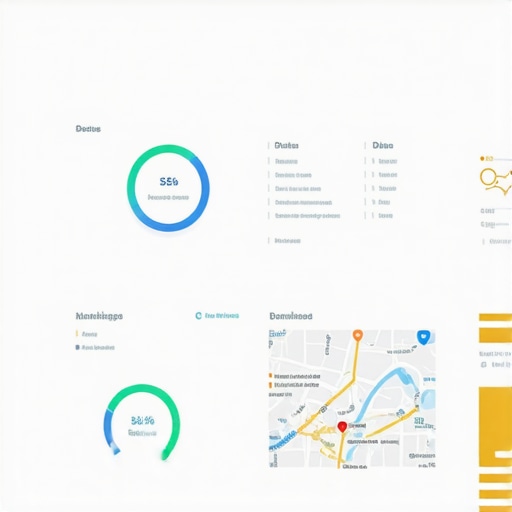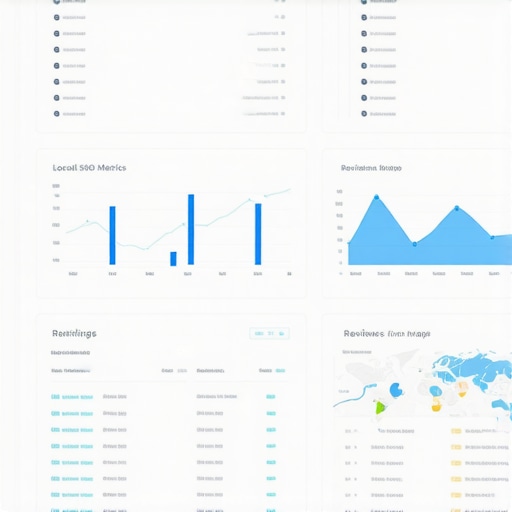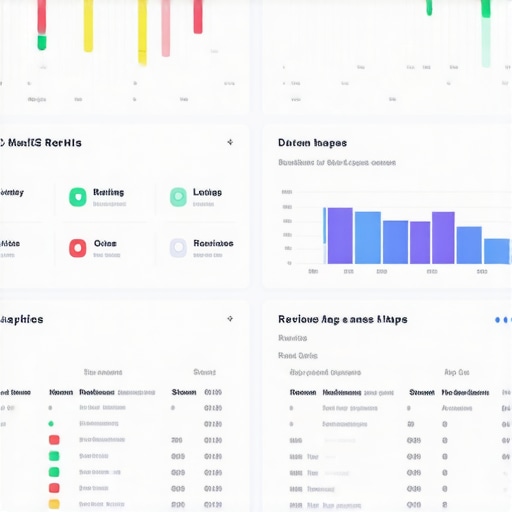My Journey into Local SEO: Finding the Perfect Report & Tracker
As a small business owner, I vividly remember the days when my local visibility was a guessing game. I spent countless hours trying to decipher my Google My Business (GMB) insights and manually tracking rankings, often feeling overwhelmed and unsure if my efforts were paying off. That was until I discovered the power of a comprehensive local SEO report and the right ranking tracker, transforming my approach and boosting my visibility in 2025.
The Power of a Local SEO Report: What I Learned
When I first started using a local SEO report, I realized how crucial it is to have accurate, actionable data. A great report consolidates insights from Google Maps, local citations, reviews, and competitors, giving me a clear picture of where I stood. I found that tools like ranking trackers and analytics platforms became my trusted allies. They helped me identify opportunities for improvement and measure my progress over time.
Choosing the Best Local SEO Report & Ranking Tracker: My Criteria
What made a report or tracker truly effective? For me, it was accuracy, ease of integration, and actionable insights. I explored options that provided maps analytics and detailed GMB performance metrics. I also prioritized tools that offered seamless integration with my existing dashboard, saving me time and confusion. It’s amazing how the right data can turn a struggling local SEO strategy into a growth story.
Why 2025 is the Year to Elevate Your Local SEO Game
Based on my experience and industry insights, 2025 is poised to be a pivotal year for local SEO. Search algorithms are evolving, and consumers are increasingly relying on local searches. According to authoritative sources, tracking KPIs like visibility, ranking fluctuations, and review sentiment is more important than ever. With the right report and tracker, I feel confident that my business can stand out amidst fierce local competition.
How Can I Ensure My Local SEO Efforts Are Truly Effective?
This is a question I often ask myself. Regularly reviewing tailored reports, staying updated with Google’s local ranking factors, and consistently adapting my strategy have been my keys to success. I encourage you to explore tools like GMB performance reports and ranking trackers to stay ahead in 2025.
If you’re looking to elevate your local visibility, I invite you to share your experiences or ask questions below. Let’s grow our local businesses together!
How Can Advanced Analytics Transform Your Local SEO Success?
For seasoned local SEO practitioners, the game is all about leveraging sophisticated data to refine strategies and outpace competitors. Beyond basic insights, integrating advanced analytics—such as maps analytics and detailed ranking fluctuations—can reveal hidden opportunities. These insights enable you to pinpoint precisely where your efforts are paying off and identify underperforming areas that need immediate attention.
The Nuances of Effective Local SEO Reports in 2025
Effective reports today go beyond surface metrics. They incorporate multi-dimensional data, including review sentiment analysis, competitor benchmarking, and local citation consistency. This holistic approach ensures your strategy isn’t just reactive but proactively optimized. For instance, tracking review sentiment over time helps you understand customer perception shifts, allowing you to craft targeted reputation management campaigns that enhance local trust and visibility.
Can Your Tracker Keep Up with Google’s Evolving Algorithm?
This is a critical question for experts. Google’s local ranking factors are continually evolving, and your ranking tracker must adapt accordingly. Tools like ranking trackers in 2025 now incorporate machine learning algorithms that anticipate ranking changes based on algorithm updates, giving you a strategic edge. Staying ahead requires understanding these technological advancements and selecting trackers that offer real-time updates and predictive insights, enabling timely strategic pivots.
What Are the Practical Implications of Integrating Analytics with Your Local SEO Workflow?
Integrating analytics into your daily workflow ensures data-driven decision-making becomes second nature. For example, combining Google My Business (GMB) performance insights with your local SEO reports helps you identify which local keywords are driving traffic and conversions. According to an expert source, such as industry leaders, having a comprehensive KPI dashboard that consolidates all these data points is essential for maintaining agility and focus in a competitive landscape. This approach minimizes guesswork and maximizes ROI.

Imagine a dashboard visualizing your local SEO KPIs, from rankings to review sentiment, all in one place—powerful, clear, and actionable.
How Can You Tailor Your Local SEO Strategy for 2025 and Beyond?
As technology advances, so should your approach. Embracing AI-driven analytics, personalized customer engagement metrics, and hyper-local targeting ensures your strategy remains effective. For example, analyzing maps analytics helps refine local content and service offerings to match evolving consumer behaviors. Staying adaptable and continually updating your data sources and tools is the key to sustained growth in this dynamic environment.
Interested in deepening your understanding? Explore more about advanced GMB performance strategies and how they can further boost your local visibility. Don’t forget to share your insights or ask questions below—your experience might be the key to unlocking new success for others!
Deepening My Understanding: Navigating the Complexities of Local SEO Analytics
As I delved further into the world of local SEO, I realized that the surface-level metrics only scratch the surface of what’s truly possible. One of the most eye-opening lessons for me was the importance of integrating maps analytics with customer engagement data. This holistic approach reveals not just where your visibility is, but how your local audience interacts with your brand at every touchpoint. It’s like having a detailed map of your customer journey, allowing me to tailor my strategies with precision and confidence.
Questioning the Limits: Can Advanced Analytics Really Predict Future Rankings?
This question constantly challenged me as I explored cutting-edge tools. I found that modern ranking trackers now employ machine learning algorithms capable of forecasting potential ranking shifts, especially after algorithm updates. These predictive insights empower me to act proactively rather than reactively, adjusting my SEO tactics before fluctuations even occur. The key is understanding that these tools are not crystal balls but sophisticated guides that, when combined with human intuition, can significantly elevate your local SEO game.
How Do I Balance Data-Driven Decisions with Authentic Customer Engagement?
This was a nuanced challenge I faced: how to leverage analytics without losing the human touch that builds trust and loyalty. I learned that data should inform my engagement strategies—like identifying review sentiment trends that highlight customer satisfaction or frustration. By responding authentically and promptly, I can enhance my reputation and foster genuine relationships. It’s about letting the data guide your empathetic responses, creating a feedback loop that continuously improves your local presence. For more insights on integrating analytics into your workflow, I recommend exploring KPIs dashboards that make this process seamless.
Visualizing Success: The Power of a Unified Local SEO Dashboard

Imagine a sleek, intuitive dashboard that consolidates your rankings, reviews, maps analytics, and engagement metrics into one accessible interface. This isn’t just a dream—it’s an achievable reality with the right tools. Having such a dashboard allows me to make quick, informed decisions and stay agile amidst the ever-changing local search landscape. It’s like having a personal co-pilot guiding your strategy, constantly adjusting based on real-time data. If you’re curious about building or optimizing your own dashboard, I highly recommend exploring top KPI dashboards for 2025.
Adapting Strategies for the Evolving Local Search Environment
As I continue to experiment and learn, I realize that adaptability is the cornerstone of sustained success. Embracing AI-driven analytics, hyper-local targeting, and personalized content ensures I stay one step ahead. For instance, analyzing maps analytics helps me identify underserved neighborhoods or niche markets, enabling targeted campaigns that resonate deeply. The landscape will keep evolving, but those who are willing to adapt and learn will thrive. If you want to deepen your understanding, explore advanced GMB strategies for even greater impact.
Now, I’d love to hear your experiences and insights. How are you leveraging analytics to refine your local SEO strategies? Share your story or ask questions below—let’s grow together in this exciting journey!
Deciphering the Next Level: How Can Sophisticated Analytics Uncover Hidden Opportunities in Local SEO?
As I delved deeper into the nuances of local SEO, I discovered that advanced analytics could do much more than just track rankings—they could serve as a crystal ball, revealing emerging trends before they materialize. Integrating tools like maps analytics with customer engagement metrics enables a comprehensive view of your local ecosystem, highlighting underserved niches and consumer behavior shifts. This layered data approach allows me to proactively adapt my strategies, ensuring my business remains agile amidst the rapidly evolving digital landscape.
Can Predictive Analytics Truly Foresee Future Local Search Rankings?
This question has been a guiding star in my journey. Modern ranking trackers harness machine learning algorithms that analyze historical data and recent algorithm updates to forecast potential ranking fluctuations. According to industry leaders, these predictive insights empower marketers to implement preemptive adjustments, turning reactive tactics into proactive strategies. While not infallible, such tools dramatically reduce guesswork, giving you a strategic edge in maintaining or improving your local visibility.
How Do I Balance Data-Driven Decisions with Genuine Customer Engagement?
This has been a nuanced challenge. Data provides invaluable insights into review sentiment, click-through rates, and engagement levels, but authentic interactions build lasting trust. I learned that responding to reviews with empathy, addressing concerns transparently, and personalizing communication based on analytics creates a virtuous cycle—enhancing reputation while informing future strategies. Combining quantitative data with qualitative feedback ensures your local SEO efforts resonate on a human level, fostering loyalty and advocacy.
Imagine a dynamic dashboard that visualizes your local SEO KPIs—from rankings and review sentiment to maps analytics—all in one intuitive interface. Such a tool transforms complex data into actionable insights, enabling quick, confident decisions that keep your strategy on course amidst the chaos of local search fluctuations.
What Are the Cutting-Edge Techniques for Hyper-Local Targeting and Personalization?
Staying ahead in local SEO requires embracing hyper-local tactics. Analyzing maps analytics reveals underserved neighborhoods and niche markets, guiding targeted campaigns that resonate deeply. Personalization extends beyond content—leveraging AI-driven tools to craft tailored offers and localized messaging ensures your business connects authentically with your community. As Google continues to refine its local ranking signals, such precision strategies will become indispensable for sustained growth.
Engaging with these advanced techniques is essential. I invite you to explore comprehensive GMB strategies to enhance your local presence further. Share your experiences or ask questions below—let’s push the boundaries of what’s possible in local SEO together!
Things I Wish I Knew Earlier (or You Might Find Surprising)
Hidden Truths About Data Accuracy
One of the biggest lessons I’ve learned is that not all local SEO reports are created equal. Early on, I relied on generic tools that often provided skewed data, leading me down the wrong path. It wasn’t until I started focusing on tools that prioritize accuracy and real-time updates that I truly saw progress. Trusting the right data is like having a compass in a foggy landscape—it keeps you oriented and moving forward.
The Power of Holistic Analytics
Initially, I thought ranking alone was enough. But integrating maps analytics with review sentiment and local citations revealed a whole new layer of insights. This holistic approach helped me understand not just where I ranked, but how my community perceives me and where untapped opportunities lie. It’s like having a 360-degree view of your local presence, guiding smarter decisions.
Predictive Analytics Are Not Magic
I used to believe that advanced trackers could predict exact future rankings. While they can forecast trends based on historical data and algorithm updates, they’re not crystal balls. The real value lies in using these insights to stay proactive—adjusting strategies before fluctuations happen, rather than reacting after the fact. It’s about leveraging technology intelligently, not blindly trusting it.
Balancing Data with Authentic Engagement
Data can tell you what’s happening, but it can’t replace genuine human connection. I’ve found that responding meaningfully to reviews and engaging with my community based on analytics creates a stronger trust bond. Combining quantitative insights with authentic interactions is the secret sauce for long-term success.
The Importance of a Unified Dashboard
Having a single dashboard that consolidates rankings, reviews, maps analytics, and KPIs transformed my workflow. It saved me time and prevented me from drowning in scattered data. Now, I can make quick, informed decisions and stay agile in an ever-changing local search landscape.
Staying Flexible in a Dynamic Environment
The local SEO landscape is always evolving, especially with Google’s continuous algorithm updates. Embracing new tools, such as AI-driven analytics and hyper-local targeting, has helped me remain competitive. For instance, exploring underserved neighborhoods with maps analytics opened up new growth avenues. Flexibility and continuous learning are key to thriving in this space.
Resources I’ve Come to Trust Over Time
- Google’s Official Local Search Resources: Google’s own support pages and blogs are invaluable for understanding ranking factors and best practices. They offer up-to-date, reliable information directly from the source.
- BrightLocal Blog: This site has been a treasure trove of practical tips, case studies, and updates on local SEO trends. I recommend it to anyone serious about staying ahead.
- Moz Local Search Blog: Moz’s insights on local SEO fundamentals and advanced strategies have helped me deepen my understanding and refine my tactics.
- Search Engine Journal: They cover a broad spectrum of digital marketing topics, including local SEO, with expert opinions and latest news that keep me informed of industry shifts.
Parting Thoughts from My Perspective
Reflecting on my journey into local SEO, I realize that success in 2025 hinges on leveraging the right tools, trusting accurate data, and continuously adapting to new trends. Combining comprehensive reports with predictive analytics and authentic community engagement has transformed my approach from guesswork to strategic mastery. If you’re serious about elevating your local visibility, start by exploring trusted resources and integrating holistic analytics into your workflow. Remember, the landscape will keep changing, but with flexibility and the right mindset, you can stay ahead of the curve. If this resonated with you, I’d love to hear your thoughts or experiences—feel free to drop a comment below or share this with someone who might find it helpful. Here’s to your local SEO success in 2025 and beyond!
